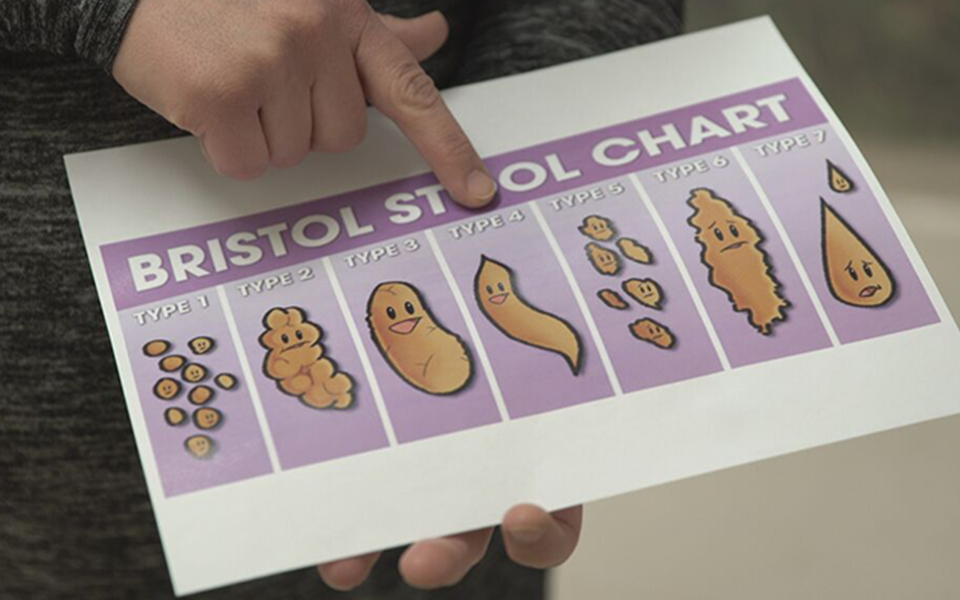
A guide to healthy bowel movements
We’re going there…today we’re talking about poop. If you’re wondering what healthy bowel movements look like, we’ve asked our experts at Hamilton Health Sciences to take a modification of the Bristol Stool Chart and show us using chocolate! The Bristol Stool Chart was developed in 1997 by Heaton, K. and Lewis, S. at the University of Bristol. It was created to categorize different types of stool, ranging from constipation to diarrhea.
What do healthy bowel movements look like?
A healthy bowel movement should fall under Type 3, 4, and 5 on the Bristol Stool Chart. Types 1 and 2 are considered constipation while types 6 and 7 are considered diarrhea. See where your stool fits on the scale with the video above.
Bristol Stool Chart
• Type 1: Separate hard lumps which can look like rocks or marbles
• Type 2: Sausage shaped, but stuck together hard lumps
• Type 3: Sausage shaped with some cracks in the surface
• Type 4: Sausage shaped, smooth and soft
• Type 5: Soft blobs, with clear edges
• Type 6: Mushy stool, flakes of stool with lots of liquid
• Type 7: Entirely liquid, watery, no solid pieces

Healthy daily routines
Healthy bowel movements are key to your child’s well-being. That’s why it’s important to look into the toilet bowl and see what’s inside, or at least have the “toilet talk” with children. The ideal frequency of bowel movements is 1 or 2 times per day. The goal is to have bowels completely emptied. Bowel movements should be soft and easy to pass, with no pain, straining or stool leakage.
Establish a bowel routine and set aside time to go in private, at the same time every day. Go when your bowel is most active (first thing in the morning and after meals) and when you feel the urge. Don’t hold it or ignore your body’s message. Relax, don’t strain, your muscles, and ensure your feet are flat on the floor or on a small foot stool for support. Good hydration and water intake (a warm glass of water can help with constipation), staying active, and eating high fiber foods regularly all contribute to healthy bowel movements.
Constipation
There are many factors that can contribute to constipation. Some people feel unable to go in public places, when there’s a change of routine or time zone such as on holidays, when there are other health conditions that affect bowel movements, or simply, when they’re not getting enough fiber, water, or exercise.
Constipation can cause problems like abdominal pain and distention, hemorrhoids and anal fissures, difficulty passing stool, urinary tract infections, and bladder problems.
If bowel movements are infrequent or difficult to pass, talk with your doctor or nurse practitioner. Seek medical attention if your child has abnormal stools, stool soiling/incontinence, painful pooping, blood in stools or infrequent bowel movements.
To encourage regular and healthy bowel movements, children should:
• Drink 1-1.5 liters of fluids per day.
• Consume 20-25 grams of fiber per day.
• Sit on the toilet for five minutes, 1-2 times per day as designated toilet time.
• Ensure feet are well supported on the floor or on a foot stool if they’re dangling.
• Only take medication (laxatives) as prescribed by a doctor or nurse practitioner.
• Eat regularly and don’t skip meals. Consume a healthy bowel diet with fresh fruit, raw vegetables, whole grains, legumes, and other high fiber foods.
Watch Dr. Elyanne Ratcliffe, pediatric gastroenterologist at HHS, give a chocolate demonstration of the Bristol Stool Chart on CHCH Morning Live.
